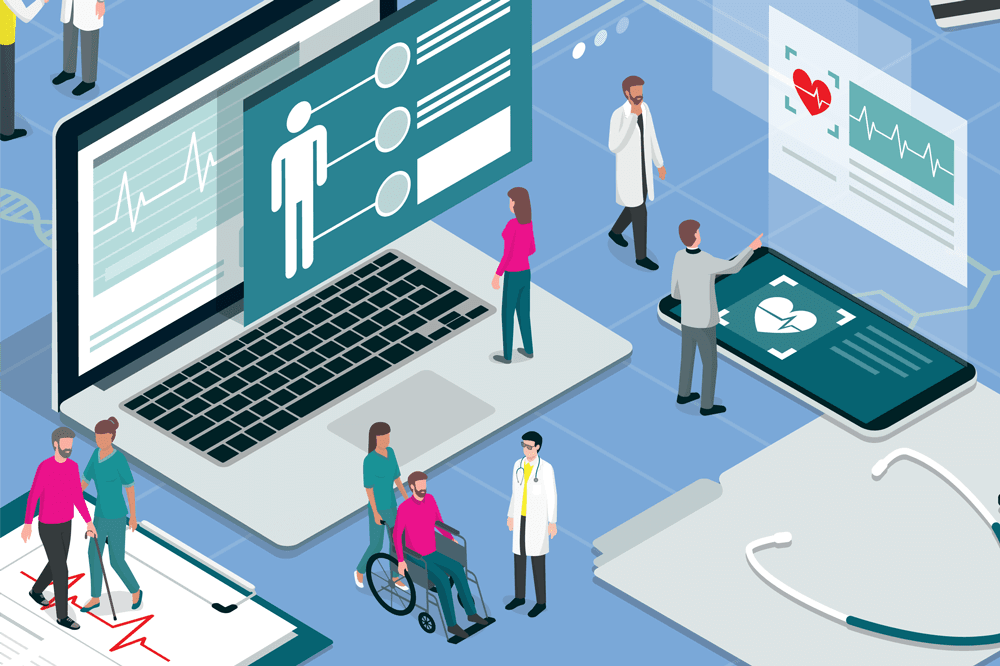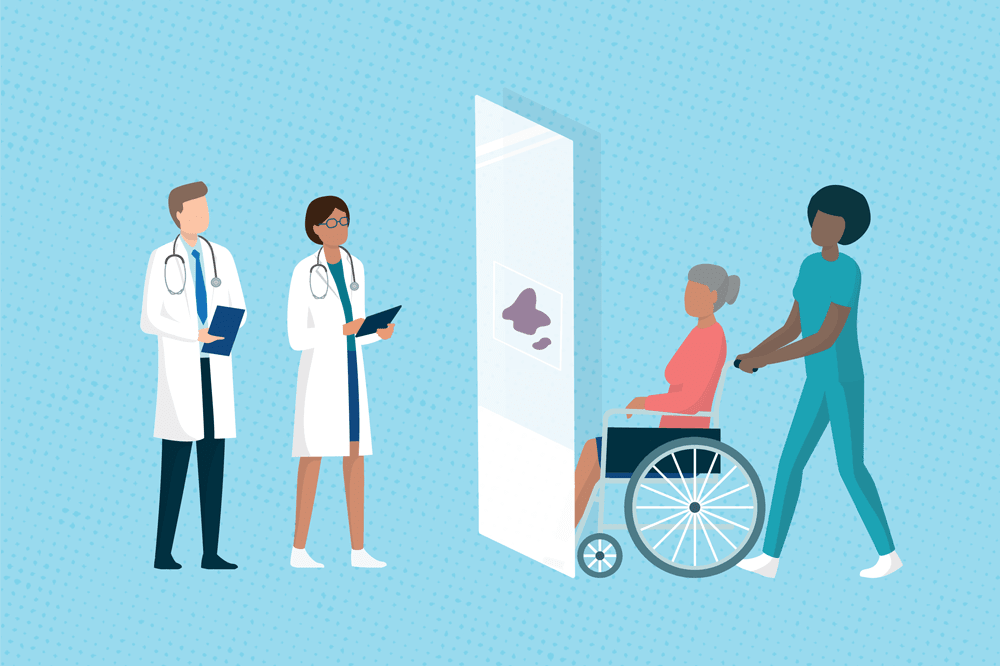
Knowledge is power – and both patients and healthcare professionals deserve as much knowledge as they can get. In my view, the 21st Century CURES Act, initially implemented in the US in 2016 and updated December 2020, offers knowledge that can help propel patient-centered care – but, surprisingly, even healthcare professionals are unfamiliar with the law and its recent updates.
The primary purpose of the update is to make health data accessible and available to patients through electronic formats such as smartphones and patient portals. Tucked away in the changes to the CURES Act are the new data-sharing regulations that bar healthcare providers, including laboratories, from engaging in any practice that may interfere with access, exchange, or use of electronic health information.
According to the US Government Federal Register, the new requirement prohibits the blocking of access to medical records and any attempt to interfere with the process. “Interference could take many forms. In addition to the prevention or material discouragement of access, exchange, or use […] interference could include practices that increase the cost, complexity, or other burdens associated with accessing, exchanging, or using [electronic health information] (EHI). Interference could also include practices that limit the utility, efficacy, or value of EHI that is accessed, exchanged, or used, such as by diminishing the integrity, quality, completeness, or timeliness of the data (1).” This provision lays the groundwork for giving patients control of their health information – including clinical or consultation notes, laboratory test results, imaging, and pathology reports – by requiring that it be available electronically in a fully automated manner and free of charge.
My husband and I had an experience which demonstrates the value of immediate access to health care records. We had no idea what could be causing the pain in Bill’s intestines and mid-back region, but his mother died of colon cancer and he is also monitored for renal cancer due to a genetic mutation, so you can imagine our concern. After several sleepless nights, we made our way to our local hospital emergency room. Unfortunately, it was at the height of the Omicron surge in our state, so we sat in the busy ER for hours, anxiously awaiting test results. Through my own patient advocacy work, I was familiar with the CURES Act and wondered – could my husband’s test results be in his patient portal in real time?
Sure enough, all his lab tests and CT scan results were available in his patient portal. Using the only device I had at the time, my smartphone, I searched online for explanations of the medical terms in the various reports to help me understand his condition. Before the emergency room doctor was able to deliver the news, we were surprised and relieved to discover that he had nothing more nefarious than his first-ever kidney stone.
Armed with this information, I went to the nursing station to ask when my husband might see the doctor. The nurse replied that the doctor was still “waiting on the labs and CT scan” – so I told her that the results were already available in my husband’s portal, using my phone to show her the reports. She was unfamiliar with the new CURES Act requirement, so I took the opportunity to educate her on the basics of the new mandate. The nurse promptly paged the ER doctor – and, shortly thereafter, Bill received his discharge instructions, freeing up an emergency room pod for another patient.
Lorraine Rosamilia, Geisinger Health System, says, “The ability for patients to own their medical data, securely access and maintain it in their portable devices, and provide time and health care worker economy for data transfer, are good technology advances (2).” The data can be used to mount and expand educational initiatives for health professionals, patients, and families; to take medical records into the next generation; to maximize patient safety; and to promote shared decision-making between clinicians and patients. It engages the patient population in transparent communication and supports family caregivers at a time of extraordinary stress.
Patients want to understand their health – and doctors should not possess information patients can’t access. By giving patients immediate access to their medical data, the new rule can lead to true partnerships with care teams. It is my hope that this expanded view of care will lead to the creation of patient-inclusive diagnostic management teams (DMTs). These teams involve a number of experts who meet to discuss test selection and interpretation in a specific disease or group of diseases – but what if the idea were expanded to include patients? Laposata mentions the need for “a simpler process that considers privacy issues and ease of use so that an expert in one geographic location can help a pathologist or other healthcare provider elsewhere in a timely and consistently effective manner (3).” The CURES Act’s medical information portability requirements could address his concern. In addition, “… diagnostic management teams improve diagnostic accuracy and ensure the patient gets the right therapy faster. Both benefits contribute to substantial reductions in the cost per healthcare encounter (4).” The CURES Act creates the opportunity to make visible every test a patient receives relative to their diagnosis – and paves the way for DMTs to form the future of every patient’s healthcare team.
This type of expanded care will help patients understand the role that the pathologist and the laboratory play, encouraging mutually beneficial partnerships that, in turn, will elevate the field. In such a system, patients can access their test results, research, and formulate questions prior to a clinic visit, increasing efficiency. However, patients need vetted tools, applications, and information to gain a better understanding of reference ranges and medical terminology. That’s why I believe more outreach by the provider community is vital – and I’m far from alone.
Thanks to the access granted by the CURES Act, opportunities for better-informed dialogues between patients and pathologists are already cropping up. Lija Joseph, a pathologist at Lowell General Hospital and a maverick in the field of pathology-patient consultations, echoed this in a recent article. “The 21st Century CURES Act will create additional opportunities where a patient and pathologist can finally meet as the patients access their pathology reports online,” she writes. “They will see the pathologists’ names on the reports and seek them out if they need more information (5).” At Lowell General, patients are already seeking out their pathologists for detailed information. When asked about the new law, Joseph says she has not yet seen an increase in her workload. However, she admits that “patients are not aware of the new law and hospitals have not been very eager to advertise this option!” The barriers to awareness are clear – so Joseph urges institutions to offer more education. “An active communication and outreach campaign is the most effective way to ‘get the word out.’”
James Wisecarver, a pathologist at the University of Nebraska Medical (UofN) Center, is an early adopter of the notion of patients’ meeting with their pathologists, so I was curious as to whether the CURES Act had impacted his work. “Since the new CURES Act rule, I have had two patients contact me regarding their pathology reports,” he says. “One had a newly diagnosed cancer; the second was confused regarding the wording in the pathology report. In the cancer case, the patient had initially tried to contact her primary physician, but was unable to reach them. I welcome any calls regarding the information contained in my reports and I am also happy to sit down and review slides with patients. However, at the UofN Department of Pathology, we have only just begun to have conversations as to how best to respond when these calls eventually come in.”
I also spoke with Anne Buckley, a pathologist at Duke Health System. She has made herself available to patients to review their pathology reports and conducts patient-pathology consultations in which she explains the complexities of a patient’s disease. She feels a sense of responsibility to patients and maintains that it is “the right thing to do.” Buckley is so forward-thinking in this area that she includes her contact information within her pathology reports so that patients can get in touch. I asked her if she had seen heightened patient desire for contact since the emergence of the CURES Act – and she has. “Previously, I tended to get inquiries from patients who had spent years trying to get a diagnosis for a rare neuromuscular disorder. They wished to talk to me about their diagnostic odyssey and to discuss the level of certainty in the diagnosis of overly complex, chronic medical conditions. However, since the implementation of the new requirement, I have seen an increase in patient inquiries about cancer diagnoses (in my specialty, brain tumors) as they seek better understanding. Because molecular testing has become much more important in diagnosis and prognosis, patients often have questions about what molecular test results mean – and because pathologists are well-placed to explain molecular tests, we have a key role to play in patient education. The CURES Act has been beneficial and a timely development in that regard. Patients are increasingly active in their medical decision-making and pathologists are now more visible to patients as an additional source of information on their disease.”
Since implementation, Buckley says, “I have received an increasing number of phone calls from patients about their pathology reports shortly after I sign them. Patients tell me that they really appreciate my taking the time to chat with them, because I can provide explanations, reassurance and general information on process (for instance, with delays). However, I cannot tell patients the next steps in treatment and I am not with them in person. In certain cases, it would be much better if they were to hear their diagnosis from their treating physician. I am available to talk to patients any time after diagnosis but, before I sign out a case with an unexpectedly bad outcome, I always contact the treating physician so that they have time to call the patient first. I am strongly in favor of patients’ having full and timely access to their medical information and, in most cases, this immediate posting is helpful and empowering. However, we must be careful to structure the system so as not to leave patients stranded in front of a computer screen looking at reams of data without anyone to explain it. We must make sure we provide human contact and connection right at what may be one of the worst moments of a person’s life.” I could not agree more with Buckley, who clearly understands and is responding to the notion of patient-centered care.
The American Society for Clinical Pathologists supports the added information-blocking requirement in the CURES Act. Matthew Schulze, Director of ASCP’s Center for Public Policy, supervises the group’s public policy activities and works with their commission on development, implementation, and oversight. At the 2022 ASCP Leadership Conference, Schultz acknowledged that, although there have been concerns from physicians and other medical groups, the ASCP will not oppose the new law. He said, “The ASCP has a policy of supporting the right of patients to obtain their test results and has embarked on several initiatives to begin to address the issues.”
Jeffrey Myers, a noted pathologist and Vice Chair of Clinical Affairs and Quality at the University of Michigan Department of Pathology, is also Chair of the ASCP Patient Champion Steering Committee. He says, “We need to shift the paradigm about how we share information with patients regarding their healthcare and become the conduit for what results mean. Labs are often the only constant in how patients receive care.” And what about the issues around helping patients understand their results? “Patients are looking at reports they do not understand; we can help empower patients while also elevating the profession. We need to start sharing the right information at the right time and empower the lab community to do more outreach and partnering with clinicians to provide quality care to patients. We should do more outreach to patients who receive bad reports – people engage more when they get a bad result, so it may be wise to start there. Another problem is what patients do with the information they obtain – making phone calls to physicians, caregivers, and advocacy organizations that lend patient support could overburden the system. If the prime focus is to help patients, what we create might help physicians too as an indirect benefit.”
Education on the CURES Act is the key to ensuring that patients and providers alike are aware of its benefits. This new law is empowering, but only if patients get the help they need to understand and interpret their reports. There is a vast amount of information and, unfortunately, misinformation on the internet. Patients will need vetted resources, reputable links, and more outreach from the provider community to patients to share test results, laboratory and pathology information in ways that are affirming and useful. This presents an opportunity for pathology and laboratory professionals to take the lead and begin to redefine the role they play in patient care and education.
The new CURES Act update is a true gift to patients. Having clinical and consultation notes, tests and laboratory results, imaging, and pathology reports freely and easily available is a game-changer. I believe it will redefine multidisciplinary care teams; in fact, I would call this new mandate the most consequential piece of legislation in patient-centered care in years. A cultural change in the field of medicine may be fast approaching – one that may be an important push toward precision medicine for all. My husband and I felt the power of the law; I hope you will, too.
References
- Health and Human Services Department, “21st Century Cures Act: Interoperability, Information Blocking, and the ONC Health IT Certification Program” (2020). Available at: https://bit.ly/3vq9Vnk.
- L Rosamilia, “Immediate Pathology Report Release to Patients – Is the 21st Century CURES Act Worse Than the Disease?” (2021). Available at: https://bit.ly/3xOxB7I.
- M Laposata, “What and why of diagnostic management teams” (2017). Available at: https://bit.ly/3rOmyYg.
- M McBride, “Innovative Pathologists and Clinical Laboratory Scientists Use Diagnostic Management Teams to Support Physicians with More Accurate, Faster Diagnoses” (2018). Available at: https://bit.ly/37LB0th.
- L Joseph, “Your Doctor, the Pathologist, Will See You Now,” Am J Clin Pathol, 156, 939 (2021). PMID: 34549266.




